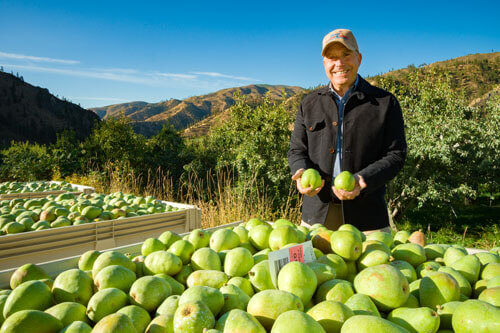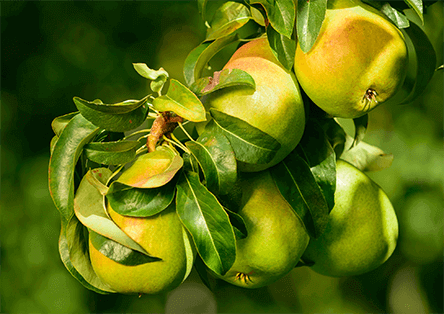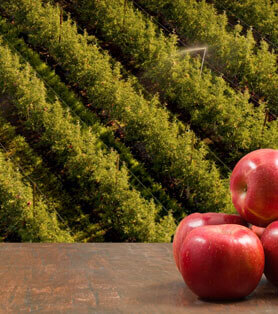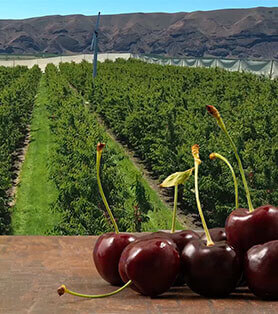Pears
Farm To Fork
Straight from the best pear locales in the world, see how our Rushing Rivers® pears go from farm to you.

Where We Grow
Where We Farm our Rushing Rivers® Pears
If you were a pear, where would you want to grow? Our multi-generational pear growers know the answer to that is a river valley, and specifically the Wenatchee River Valley and Entiat River Valley in northcentral Washington.
Our Rushing Rivers® pears grow up in the two best pear locales in the world. The regions run parallel to each other, separated only by hillsides and alpine mountains. The soil is rich with nutrients from volcanic activity long ago. The mountains protect delicate pears by offering cooler temperatures during the hot summer, and great airflow to maintain clean, high-quality fruit during the growing season. And the rushing rivers next to our orchards provide a clean and constant water supply.
These river valleys are stunning spots to see, and most importantly, the place you want to grow if you were a pear. You can learn more about these two unique locales from our farming expert, Tate Mathison.

How We Grow
To grow Rushing Rivers® pears, they must go through all four seasons to achieve high quality and amazing flavor. Every winter, our trees will go into a dormant state to rest. Not only does this help the next year’s crop flourish, but it also gives our crews time to prune to help balance the following year’s crop.
Once the snow melts and warmer temperatures are on the horizon, our pears begin to blossom. Farmers take precautions during the spring months because of unpredictable spring weather. Many growers rely on orchard heaters, wind machines and other tools to protect the flowers or tiny fruits from frost. Once pollenization occurs, Rushing Rivers® pears are well on their way to becoming real pieces of fruit!
During the heat of summer, watering and feeding is dialed in to ensure trees are getting necessary nutrients. Pear thinning also occurs to help with fruit sizing. By late summer, pear harvest is underway with Tosca, Bartlett and Starkrimson coming off the tree!
When fall arrives, pear harvest is in full swing. We harvest favorites like Bosc, d’Anjou, Red d’Anjou, and specialty varieties like Concorde. Many aren’t aware, but every pear is hand-picked off the tree!
After harvest wraps up in October, compost is applied to the base of the tree to feed trees once they complete their winter nap. By late October or November, the leaves will turn and start to fall off the tree, they go dormant, and the orchard will have a calm moment before the cycle begins again.
Storage & Packing
Storing Pears
Pears are close relatives of apples, and like their cousins, can maintain great flavor and quality well beyond harvest through Controlled Atmosphere (CA) storage rooms.
So, how does CA Storage work? Pears are picked at optimal pressures, and either packed immediately, or sent to a CA room. The rooms are sealed, carbon dioxide and oxygen levels are monitored, and the oxygen becomes so low that the fruit essentially falls asleep. This keeps the pears at the same state as they were during harvest. The rooms are sealed and closely monitored until it’s time to pack and ship them.
The length of storage depends on fruit quality, and we have many tools in place to monitor that process to take them out of CA at the perfect time. Once the fruit is ready to be shipped, the room is opened, and the fruit wakes up and begins to ripen. This amazing technology for storing pears allows us to give you a juicy, sweet pear nearly year-round!
Packing Pears
Once off the tree, we receive bins of pears from the orchard at our packing facility. The fruit is either packed quickly or placed into CA storage. Once on the packing line, pears are transported via a water channel. They are rinsed, washed, rinsed again, and dried before we do an initial quality sorting by hand.
After that first inspection, pears are sized and sorted by a machine that uses imaging software to analyze the fruit. The sorted pears are placed by hand into bags, or stickered and then placed into a tray and carton. Packed cartons are either put pears back into CA to await shipping, or stacked onto a pallet to make their way to your store.




